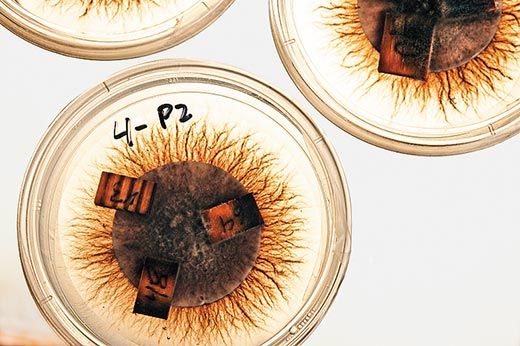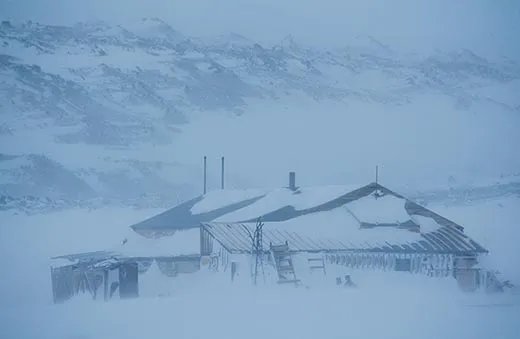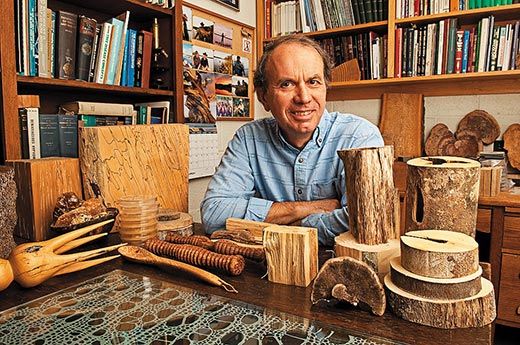Finding Feisty Fungi in Antarctica
In a place where no one believed they existed–-treeless Antartica–wood fungi are feasting on polar exploration relics
/https://tf-cmsv2-smithsonianmag-media.s3.amazonaws.com/filer/Antarctica-fungus-631.jpg)
Since there are 100,000 known fungus species, it might not seem all that remarkable that Robert Blanchette may have discovered three new ones. But he found the fungi where no one believed they existed—Antarctica—and he says they're feasting on historic treasures—the wooden huts built a century ago by legendary British explorers Ernest Shackleton and Robert Scott.
The three small buildings, constructed during Shackleton's and Scott's efforts to explore Antarctica and reach the South Pole between 1901 and 1915, are considered invaluable links to the "heroic age" of polar exploration, when eight nations launched 15 Antarctic expeditions between 1895 and 1917. The huts, among the only remaining structures from humanity's first known attempts to inhabit the continent, are overseen by the New Zealand-based Antarctic Heritage Trust, and scientists, eco-tourists and history buffs visit the structures, where they marvel at the artifacts—such as newspaper clippings, cans of food and clothing—left behind by Shackleton's and Scott's expedition members. When conservationists noticed signs of decay in the huts—rotting planks and wooden crates covered with black speckles—they knew who to consult.
Blanchette, a 57-year-old plant pathologist at the University of Minnesota, is a leading specialist in the study of how fungi affect archaeological artifacts. Originally focused on forest diseases—such as root rot and white pine blister rust—he raised his profile in 1988 when he delivered a paper describing the fungal decay of wooden relics from an excavated Native American village in Washington State. "I realized right away that I wanted to enlist him," recalls Elizabeth Simpson who, in 1981, had established a project at the University of Pennsylvania for studying and preserving royal wooden furniture from Gordion, Turkey. "I was entranced by this esoteric field of wood pathology that I had never thought about before." In the decades that followed, Blanchette studied wooden remains from the Atlantic Ocean, from Asian, African and North American deserts and from both poles. Thousands of samples—from millimeter-long slivers of a Turkish tomb that may have belonged to King Midas to a fist-size chunk from a sunken Civil War battleship—are stashed in more than a dozen freezers in his lab on the university's St. Paul campus. In each instance, his job is to identify fungi that might be damaging the artifacts and recommend ways to stop it.
"He is the best guy in the world to go to," says Robert J. Koestler, director of the Smithsonian Institution's Museum Conservation Institute, who enlisted Blanchette's help in the 1990s when Koestler was a research scientist at the Metropolitan Museum of Art.
On the day I visited Blanchette's lab, he was peering at a computer screen bearing images of rotted wood cells magnified up to 8,000 times by an electron microscope. One picture zoomed in on a dime-size piece of wood; it revealed white, oblong circles smushed together and pocked with holes, the signature of a soft-rot fungus. "Oh jeez, isn't that beautiful," Blanchette said.
That's not how most people think of fungi—often repulsive organisms that include mushrooms, molds, mildews and rusts. Unlike plants, fungi have no chlorophyll and function as parasites, living off plants or scavenging the remains or detritus of other life-forms. A fungus that attacks wood (called lignicolous) typically sustains itself by secreting enzymes that break down lignin, cellulose and other tough polymers into simpler molecules that serve as nutrients.
Before Blanchette, no mycologist had documented any wood-degrading fungi native to Antarctica. After all, fungi generally prefer warmth, and no trees have grown on the frozen continent for millions of years. But when Blanchette compared the DNA of the fungi discovered at the explorer huts with a database of known species, he found three types of fungi that were clearly distinct from any temperate species that the explorers or later visitors might have brought with them.
It appears, then, that the three huts are being attacked, in part, by native species. Scott, who commanded the first British-led expedition in 1901-4, built the oldest of the three at McMurdo Sound. "The discomfort of the hut was a byword on the Expedition," recalled Shackleton, who served as Scott's lieutenant on the ship Discovery. The group came within 530 miles of the South Pole, but had to be rescued by ships dispatched by the British Admiralty when Discovery got trapped in ice.
Shackleton had higher regard for the base camp that his own 1907-9 expedition erected at Cape Royds, 23 miles north of Scott's hut. "Here the whole shore party lived in comfort through the winter of 1908," he wrote. In early 1909, Shackleton's party left the shelter for the 850-mile trek to the pole but stopped 97 miles short when they grew low on rations. (A Norwegian expedition led by Roald Amundsen nearly three years later would be the first to reach the pole.)
Scott built the third hut at Cape Evans during his ill-fated 1910-13 expedition, when all five members of his team perished from cold and starvation. It would prove crucial for Shackleton in 1915, when some of his men became stranded. "The hut became the permanent living quarters for the ten marooned men," Shackleton wrote.
Blanchette and his team have traveled to Antarctica each of the past nine years to collect hut samples and test ways of preserving them. Back in the lab, the researchers put bits of infected wood into petri dishes filled with a nutrient-rich gel that coaxes the fungi out of the wood and encourages growth.
Blanchette then transplanted the growing samples onto pieces of pine, birch and spruce—woods used in the Antarctic huts—to see if the lab wood would similarly decay. Then, comparing DNA from the Antarctic samples of fungi with that of known species, Blanchette and his team deduced they had found three new species. He will carry out additional taxonomic study to make sure.
In any event, Blanchette says he's delighted to be studying some "really tough fungi," capable of eking out an existence in one of the planet's most inhospitable environments. He speculates the fungi lived off penguin guano, moss, lichen and material in the soil until the explorers arrived and provided a veritable feast—the first wood Antarctica had seen in eons.
Blanchette and his team have advised the Antarctic Heritage Trust about protecting the huts. Because fungi need moisture, the researchers recommended clearing out a century's worth of accumulated ice under Shackleton's hut (revealing stores of whiskey in the process) and removing 100 tons of snow and ice that accumulate annually behind Scott's hut at Cape Evans.
Blanchette, meanwhile, made another observation: one species of Antarctic fungus appears to be feasting on petroleum spilled from leaky fuel containers that Scott left behind at Cape Evans. If so, Blanchette speculates that the fungus—or enzymes extracted from it—could be put to work digesting petroleum spills.
That's what Blanchette says he loves about his work—the unexpected developments and the surprising resilience of life. No matter the environment, he says, "we're always finding great fungi."
Emily Stone is a Chicago-based writer who spent two summers in Antarctica.


